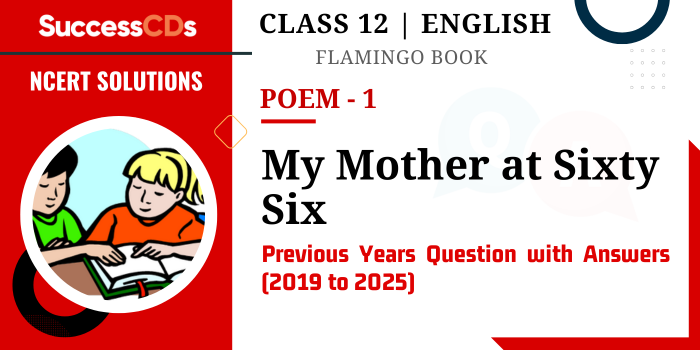CBSE Class 12 English Core Flamingo Book Poem 1 My Mother at Sixty Six Question Answers from previous years question papers (2019-2025)
My Mother at Sixty Six Previous Year Questions with Answers – Question Answers from Previous years Board Exam Question papers provide valuable insights into how chapters are typically presented in exams. They are essential for preparing for the CBSE Board Exams, serving as a valuable resource.They can reveal the types of questions commonly asked and highlight the key concepts that require more attention. In this post, we have shared Previous Year Questions for Class 12 English Core Poem 1, “My Mother at Sixty Six”.
Questions which came in 2024 Board Exam
Q1. Read the following extracts and answer the questions :
I saw my mother,
beside me,
doze, open mouthed, her face
ashen like that
of a corpse and realized with
pain
that she was as old as she
looked but soon
put that thought away, and
looked out at Young
Trees sprinting, the merry children spilling
out of their homes.
(i) The phrase ‘ashen like that of a corpse’ gives the impression that the mother is
(A) frustrated
(B) depressed
(C) dead
(D) weak
Ans. (D) weak
(ii) State whether the following statement is True or False, with reference to the extract.
“The mother was suffering from some fatal disease.”
Ans. False
(iii) Which of the following themes is best represented in the given extract?
(A) Life is short and one must enjoy it
(B) Ageing and Mortality
(C) Sleeping and Playing
(D) Art of Parenting
Ans. (B) Ageing and Mortality
(iv) Pick the option in which the word ‘spilling’ is used in the same sense as in the extract.
(A) Rahul was responsible for spilling the beans by telling everyone the secret.
(B) He opened the bag, spilling all its contents on the table.
(C) Try to keep that crowd from spilling onto the main street.
(D) The cat spilled all the milk.
Ans. (C) Try to keep that crowd from spilling onto the main street.
(v) The phrases ‘Young Trees sprinting’ and ‘merry children spilling’ represent :
(A) Youth
(B) Old age
(C) Disease
(D) Travel
Ans. (A) Youth
(vi) Complete the sentence appropriately.
‘She was as old as she looked.’
The repetition of the word ‘as’ suggests that ___________.
Ans. The poet is emphasizing the reality and the undeniable truth of her mother’s aging.
Q2. Read the following extracts and answer the questions :
… but soon
put that thought away, and
looked out at Young
Trees sprinting, the merry children spilling
out of their homes, but after the airport’s security check,
standing a few yards away, I looked again at her, wan, pale
as a late winter’s moon and felt that old
familiar ache, my childhood’s fear,
(i) Select the correct option.
The impact of ‘merry children’ on poet’s mind _________.
(A) caused anxiety
(B) created a sense of longing
(C) brought comfort
(D) reminded her of her own childhood
Ans. (C) brought comfort
(ii) The tone of the poet expressed in the above lines is
(A) sadness and helplessness
(B) excitement and eagerness
(C) appreciation and gratitude
(D) anger and anxiety
Ans. (A) sadness and helplessness
(iii) The words ‘wan, pale’ indicate the mother’s _______.
Ans. The words ‘wan, pale’ indicate the mother’s frail health and aging.
(iv) Complete the following sentence appropriately.
The poet looked at her mother again to _______.
Ans. The poet looked at her mother again to capture and remember her frail image, fearing it might be the last time she sees her.
(v) Explain one inference that can be drawn from the line ‘felt that old familiar ache’.
Ans. The poet experiences a deep, familiar sorrow and fear of losing her mother, a feeling she has had since childhood.
(vi) ‘put that thought away’.
What is the intention of poet that can be inferred from the above line?
Ans. The poet tries to distract herself from the painful thought of her mother’s impending death by focusing on other things.
Q3. It is said that the ‘Face is a mirror of one’s emotions.’ Why did the poet ‘smile and smile’? [40-50 Words]
Ans. She smiled to hide her inner feeling of sadness. She was feeling the pang of separation from her mother but she hid it behind her fake smile.
Q4. “See you soon Amma.” How are these words contrary to the speaker’s emotions? [40-50 Words]
Ans. The words ‘See you soon Amma’ are contrary to the speaker’s emotions because she is actually filled with fear and sadness about her mother’s aging and the possibility of losing her. The cheerful farewell masks her inner turmoil and concern.
Q5. Create a comprehensive comparison of the themes present in ‘Aunt Jennifer’s Tigers’ and ‘My Mother at Sixty-six’. Specifically discuss the different ways each poem addresses the concept of struggle and resilience. [120-150 Words]
Ans. The poem Aunt Jennifer’s Tigers is based on the theme of a woman’s desire of living a free life. It highlights the bindings of married life and fear of her husband which will accompany her even after death. The other poem ‘My Mother at Sixty-six’ conveys the message of fear and separation. It shows a woman’s helplessness towards her old ailing mother when she has to leave her and go. The woman hides her feeling from the mother with a false smile.
In both the poems we see a married woman’s struggles. Aunt Jennifer is subjected to agony at the hands of her husband and the marital obligations pressurize her so much that while doing her favourite hobby, her fingers flutter due to his fear. She depicts her inner feeling of fearlessness and boldness through the pattern that she is making. Thus, her desire is not dead and we see that she is resilient and has the desire to bounce back. The poet Kamala Das, in ‘My mother at sixty-six’ is also struggling with the fear of losing her old mother to death. Still, she overcomes the fear and smiles towards the mother. She hopes to see her mother again and on this positive note, she departs.
Thus, both the poems show the struggle and also, show their inner strength which supports them in overcoming the sadness and being happy.
Q6. Write a paragraph focusing on how the poems ‘Keeping quiet’ and ‘My Mother at Sixty-six’ illuminate different facets of human introspection and the significance of quiet reflection in understanding oneself. [120-150 Words]
Ans. In the poem ‘Keeping Quiet’ the poet makes a direct request to the reader to remain quiet, stop working and introspect. He wants them to ponder over the repercussions of their acts so that they can make better decisions for the future. In the poem ‘My Mother at Sixty-six’ the poet sees her old and aging mother whose face looks like a corpse. However, she chooses to keep her pain within and hides it behind a fake smile. She keeps on thinking that her mother needs her, and is fearful of losing her forever. However, these thoughts remain inside her. She remains silent and keeps on introspecting about her mother. Finally, she smiles at her and leaves.
In both the poems, we see the importance of quiet reflection. The ability to develop an idea within one’s mind and then, deciding the future actions leads to better decisions for the future.
Q7. How does the use of vivid imagery by Adrienne Rich in “Aunt Jennifer’s Tigers” and by Kamala Das in “My Mother at Sixty-six” contribute to the overall themes of their respective poems? [120-150 Words]
Ans. Both the poems have visual imagery which contributes to the theme of the poem. In Aunt Jennifer’s Tigers, the tigers prance… They do not fear the men; this shows the aunt’s desire of freedom. They pace in sleek chivalry indicates her desire to live fearlessly. Aunt’s finger flutter when she pulls the needle shows her fear of the husband who may question her hobby. The wedding ring on her hand sits heavily which indicates the pressure of marital obligations. Thus, the entire poem involves visual depictions.
In My mother at sixty-six, the mother’s face is ashen, like a corpse which makes the reader visualize a dull, ash coloured face which resembles a dead body. Then, the poet sees young trees outside the car which seem to be running, young children running and playing in the garden. These scenes are lively and energetic and she puts them in opposition to the scene inside the car, the corpse like old mother sitting beside her. Later, the mother’s face is dull, like the winter moon which can again be visualised by the reader. Thus, she has also used visual imagery to show her feelings of fear of losing her mother to death.
Q8. How do imagery and symbolism in the poems “Aunt Jennifer’s Tigers” and “My Mother at Sixty-six” offer insights into relationships? Write a diary entry expressing your thoughts. You may begin this way :
I read the two poems today and … [120-150 Words]
Ans. I read the two poems today and both have used imagery and symbolism express relationships.
The poem Aunt Jennifer’s Tigers is all about marital relations. The tigers are a symbol of fearlessness and pride which depict the aunt’s desire. The tigers prance across the world of green and do not fear the men beneath the tree creates visual imagery to present aunt’s desire of living with freedom and without fear. The uncle’s wedding band is a symbol of the burdening marital obligations which pressurize the aunt and the word ‘ringed’ show that she is wearing the wedding ring and also, that she is surrounded by the marital obligation unto her death. Her terrified hands find the ivory needle hard to pull creates a scene where the reader can imagine that the woman is scared of the husband who will perhaps object to her hobby of doing embroidery.
The poem My mother at Sixty-six is about filial relationship. The mother’s face is ashen, like a dead body. Then, the poet sees young trees outside the car which seem to be running, young children running and playing in the garden. These scenes are lively and energetic and she puts them in opposition to the scene inside the car, the corpse like old mother sitting beside her. Later, the mother’s face is dull, like the winter moon which can again be visualised by the reader. Thus, she has also used visual imagery to show her feelings of fear of losing her mother to death.
Both these poems highlight the nuances of the relationships that they talk of.
Questions from the Poem in 2023 Board Exams
Q1. Read the following extract and answer the questions that follow :
I saw my mother,
beside me,
doze, open mouthed, her face
ashen like that
of a corpse and realised with
pain
that she was as old as she
looked but soon
put that thought away, and
looked out at Young
Trees sprinting, the merry children spilling
out of their homes,
(i) Identify the phrase that indicates youthful energy.
Ans. Young
Trees sprinting, the merry children spilling
out of their homes,
(ii) Which thought is the poet trying to put away?
(a) missing the flight
(b) fear of losing her mother
(c) leaving her mother behind
(d) reaching Cochin
Ans. (b) fear of losing her mother
(iii) The poet’s mother is described as ‘open mouthed’ because _______.
(a) she is curious
(b) she is surprised
(c) she was dead
(d) she was dozing
Ans. (d) she was dozing
(iv) Complete the following analogy :
children spilling : metaphor : : _________ : personification
Ans. Trees sprinting
(v) The sight of the trees and the children helped the poet ________.
Ans. put the thought of her old, aging mother away
(vi) In the given extract, the phrase ‘realised with pain’ indicates the poet’s
(a) anxiety
(b) desperation
(c) troubled past
(d) ill-health
Ans. (a) anxiety
Q2. Read the following extract and answer the questions that follow :
Driving from my parent’s
home to Cochin last Friday
morning, I saw my mother,
beside me,
doze, open mouthed, her face
ashen like that
of a corpse, and realised with
pain
that she was as old as she
looked but soon
put that thought away, and
looked out at Young
Trees sprinting, the merry children spilling
out of their homes …….
(i) The poet’s mother looks
- exhausted
- healthy
III. rejuvenated
- pale
- relaxed
Choose the most appropriate option :
(a) Only V
(b) I, III and V
(c) I, II and IV
(d) I and IV
Ans. (d) I and IV
(ii) The poet looks out of the car because ____________.
Ans. she wants to put the thought of her old, pale mother away
(iii) Choose the option that displays the same poetic device as ‘her face ashen like that of a corpse’.
(a) stars winked in the midnight sky
(b) a bitter sweet experience
(c) as cold as ice
(d) grey geese in the green field
Ans. (c) as cold as ice
(iv) The phrase ‘she realized with pain’ indicates the poet’s
(a) anxiety of missing the flight.
(b) fear of losing her mother.
(c) fear of illness.
(d) anxiety of taking her mother on the flight.
Ans. (b) fear of losing her mother.
(v) On the basis of the extract, study the two statements, I and II given below :
- The poet was in a hurry to reach the airport.
- The poet did not want to think about her mother growing old and infirm.
Choose the most appropriate option :
(a) I is correct, but II is incorrect
(b) Both I and II are correct
(c) Both I and II are incorrect
(d) II is correct, but I is incorrect
Ans. (d) II is correct, but I is incorrect
(vi) What does the phrase ‘sprinting trees’ symbolize?
(a) youthfulness and forgetfulness
(b) vitality and youthfulness
(c) energy and casualness
(d) pallor and exuberance
Ans. (b) vitality and youthfulness
Q3. Read the following extract and answer the questions that follow:
but after airport’s
security check, standing a few yards
away, I looked again at her, Wan,
pale
as a late winter’s moon and felt that
old
familiar ache, my childhood’s fear
but all I said was, see you soon,
Amma,
All I did was smile and smile and
smile ……..
(i) Choose the correct option :
In the above extract the narrator feels
(a) satisfied
(b) fearful
(c) nostalgic
(d) regretful
Ans. (b) fearful
(ii) Identify the word in the extract that means ‘colourless’.
Ans. pale
(iii) Complete the following analogy correctly :
She sang like a bird : Simile
All I did was smile and smile and smile : ____
Ans. Repetition
(iv) Read the following statement and choose the correct option :
(1) The poet had gone through the security check.
(2) She did not want to look at her mother.
(a) (1) is true, but (2) is false.
(b) (1) is false, but (2) is true.
(c) Both (1) and (2) are true.
(d) Both (1) and (2) are false.
Ans. (b) (1) is false, but (2) is true.
(v) What childhood fear is the poet referring to?
Ans. The poet Kamala Das in her poem ‘My Mother at Sixty Six’ is referring to fear of separation from her mother forever just as a child is always insecure of getting separated from her mother whenever she is not visible or nearby to him/her.
(vi) Fill the blank with appropriate words with reference to the extract :
Pale as a winter’s moon suggests _______.
Ans. Suggests the mother’s weak and withered face.
Q4. Read the following extract and answer the questions that follow:
I looked again at her, wan,
pale
as a late winter’s moon and felt that
old
familiar ache, my childhood’s fear,
but all I said was, see you soon,
Amma,
all I did was smile and smile and
smile …
(i) The poem ‘My Mother at Sixty-Six’ captures the _____ of the narrator.
- happiness
Il. fear
Ill. dismay
- anxiety
Choose the most appropriate option :
(a) Only lI (b) I and IV
(c) II and IV (d) Only III
Ans. (c) II and IV
(ii) Identify the phrase from the extract that suggests the following :
She was overwhelmed with emotion and could not speak much.
Ans. ‘but all I said was, see you soon, Amma’.
(iii) The word ‘wan’ in the given context most nearly means
(a) pale
(b) old
(c) unwell
(d) anxious
Ans. (a) pale
(iv) Complete the following analogy correctly. Do not repeat from the example used.
Trees sprinting : personification : : ____ : simile
Ans. pale as a late winter’s moon
(v) On the basis of the extract, study the two statements, I and II given below :
- The poet accepts the reality of her mother’s declining health and old age.
- She is nostalgic about her childhood days spent with her mother.
Choose the most appropriate option :
(a) I is true, but II is false
(b) Both I and II are true
(c) II is the reason for I
(d) II cannot be inferred from the extract
Ans. (c) II is the reason for I
(vi) Explain the following statement with reference to the above extract :
All I did was smile and smile and smile.
Ans. The poetess hides her anxiety and worries about being separated from her mother beneath her hurt smile.
Q5. What is the significance of the word ‘but’ in ‘but all I said was see you soon, Amma? [40-50 Words]
Ans. The significance of the word “but” in the line “but all I said was see you soon, Amma?” from the poem “My Mother at Sixty-Six” by Kamala Das is to contrast the speaker’s actual thoughts and emotions with what she said out loud. The word “but” indicates a contrast, and suggests that the speaker’s thoughts and feelings were much more complex and emotional than what she said. The use of “but” suggests that the speaker is holding back her true feelings and emotions, and that there is an unspoken tension between her and her mother.
Q6. What are the feelings of the poet about her aged mother with reference to the poem ‘My Mother at Sixty Six’? [40-50 Words]
Ans. In the poem titled “My Mother at Sixty-Six,” the poet Kamala Das conveys a profound sense of love as well as concern for her mother, who is getting older. As her mother sleeps in the car, she is able to watch her mother’s weakness and fragility. This causes her to be overtaken with a sense of protectiveness and tenderness towards her mother, which she realises is a natural response to the inevitable process of ageing.
Questions from the Poem in 2020 Board Exams
Q1. Read the extracts given below and briefly answer the questions that follow each.
Driving from my parent’s
home to Cochin last Friday
morning, I saw my mother,
beside me,
doze, open mouthed, her face
ashen like that
Of a corpse and realised with
pain
that she was as old as she
looked … … … …
(i) Where was the poet driving to? Who was sitting beside her?
Ans. Cochin, her mother
(ii) What did the poet notice about her mother?
Ans. Her face looked was the colour of ash and it looked like a corpse
(iii) Which thought made the poet feel painful?
Ans. The thought of losing her mother
(iv) Name the figure of speech used in the expression : ‘her face ashen like that of a corpse’
Ans. Simile
Q2. What were the poet’s feelings on her way to the airport? [30-40 words]
Ans. The poet felt pain and fear of losing her aging mother to death.
Q3. Why has the poet mentioned ‘merry children spilling out of their homes’ in the poem? [30-40 words]
Ans. The scene outside the car of merry children spilling out of their homes was contrast to the scene inside the car. She mentions it to create a juxtaposition between the scenes inside and outside the car.
Q4. How does the poet describe her mother in the poem, ‘My Mother at Sixty-six’? [30-40 words]
Ans. Her mother is described as ancient and pallid by the poet. The mother looked almost like a corpse as she drifted off alongside daughter, her face colourless and devoid of the passion of life.
2019 Exam Question and Answers from the Poem
Q1. Read the extract given below and answer the questions that follow :
I looked again at her, wan, pale
as a late winter’s moon and felt that old
familiar ache, my childhood’s fear,
but all I said was, see you soon, Amma,
all I did was smile and smile and smile ……
(i) Name the poet and the poem.
Ans. Kamala Das is the poet and the name of the poem is ‘My Mother at Sixty-Six.’
(ii) What was the poet’s childhood fear ?
Ans. The poet’s childhood fear was that her mother would leave her alone and go away.
(iii) What is the poetic device used in lines 1- 2 ?
Ans. The poetic device used in lines 1-2 is simile.
(iv) Explain : ‘late winter’s moon’.
Ans. Late winter’s moon appears dull and hazy and it has no brightness. Similarly, poet’s mother also looks tired and lifeless.
Q2. Read the extract given below and answer the questions that follow :
but soon
put that thought away, and
looked out at young,
trees sprinting, the merry children spilling
out of their homes.
(a) Name the poem and the poet.
Ans. My Mother at Sixty Six by Kamla Das
(b) What thought did the poet put away?
Ans. The thought of her aging mother
(c) Why are the young trees described as sprinting?
Ans. When seen from a moving car, the trees by the roadside seem to be sprinting in the opposite direction.
(d) How do you know that the joyful scene did not help her drive away ‘that thought’ from her mind?
Ans. Again she mentions that however, after the security check at the airport, she again linked at her mother who appeared weak and pale like a winter’s moon.
Q3. What sort of pain does the poet feel in ‘My Mother at Sixty-six’? [30 – 40 words]
Ans. She feels a pain of losing her mother and being separated from her forever.
Q4. In the last line of the poem, ‘My Mother at Sixty-six’, the word ‘smile’ is repeated three times. What is its significance? [30 – 40 words]
Ans. The poet repeats the work ‘smile’ to indicate her false smile behind which she treis to hide her pain.
Q5. What is the poet’s childhood fear? [30 – 40 words]
Ans. The poet’s childhood fear in the poem, My Mother at Sixty-Six, is that of losing her mother’s company. Through the poem, the poet has tried to depict how the time is nearing. During this her fears will turn into reality, and this makes her feel unhappy and worried at the same time, for her mother has already moved into her old age and is nearing her last days. Her childhood fear appears to grip her again. When the poet sees the corpse-like and pale face of her mother, her ache or the old familiar pain returns. Perhaps this fear was entertained by her since her childhood.
Also see:
My Mother at Sixty Six Question Answers
My Mother at Sixty Six Summary, Explanation
My Mother at Sixty Six Character Sketches




superb. very useful
Very very useful and good quality ☺️